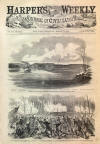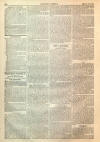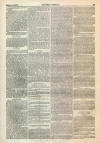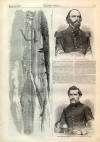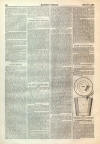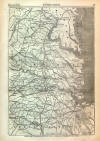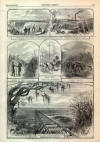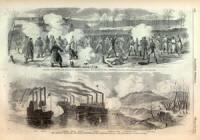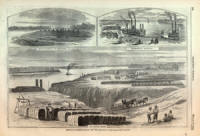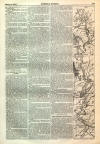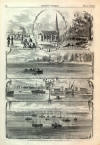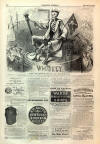Fight at Fort Donelson
|
|
This Site:
|
HARPER'S WEEKLY. [MARCH 15, 1862. 166 (Precious Page) of Washington, and called on him to draw his weapon. Lander replied that he had too much respect for the laws of his State—Massachusetts—to carry concealed weapons, but he would fight Magraw without them. He denounced him as a liar and coward, and kicked him, revolver and all, down the street. On the outbreak of the rebellion Lander was appointed Brigadier-General, and served under McClellan in Western Virginia. At the celebrated battle of Rich Mountain he distinguished himself by the most daring achievements and the most imperturbable coolness. One of the officers engaged on that day stated in his report that Lander was to be seen on horseback gallantly plunging up the side of a hill, and "leading the leaders." He is also reported to have ridden fifteen feet ahead of our forces, and, notwithstanding that a shower of bullets greeted his presence as soon as discovered by the enemy, he did not seem to be in the least alarmed, but stubbornly defied the dangers that surrounded him, while he cheered on his comrades to victory. It is unnecessary to say that he was idolized by the soldiers. The deceased was also in the unfortunate engagement of Edward's Ferry or Ball's Bluff, where the gallant Baker met a soldier's death at the head of his column. In that disastrous affair Lander behaved with characteristic coolness and valor, receiving a wound in the calf of one of his legs, which at the time was not considered of a dangerous character. But the most important feat performed by General Lander was his late opening of the railroad and telegraph to Hancock, Virginia, which he accomplished with two thousand men in two columns, marching thirty-two miles in a space of time never, perhaps, exceeded. The services of the deceased, on this occasion, were so highly prized by the Government as to elicit the following exceedingly flattering and honorable letter from the Secretary of War: WAR BULLETIN—THANKS TO GENERAL LANDER. WAR DEPARTMENT, WASHINGTON, Feb. 17, 1862. To Brigadier-General F. W. Lander: The President directs me to say that he has observed with pleasure the activity and enterprise manifested by yourself and the officers and soldiers of your command. You have shown how much may be done, in the worst weather and worst roads, by a spirited officer at the head of a small force of brave men, unwilling to waste life in camp when the enemies of their country are within reach. Your brilliant success is a happy presage of what may be expected when the Army of the Potomac shall be led to the field by their gallant general. EDWIN M. STANTON> Secretary of War. CAPTAIN MENDILL.CAPTAIN NOAH E. MENDILL, Company I, Seventh Regiment Illinois Volunteers, whose portrait will be found on page 165, was the first man of note, and one among the best men, who fell on the bloody field of Donelson. A day or two before the attack on Fort Donelson, while encamped near Fort Henry, our young hero was severely hurt by a tree falling in the night on his tent. It struck him across the loins, injuring his kidneys to such an extent that he was unable to walk. He was carried to the hospital, where he was still confined when the order was given, "Forward to Fort Donelson!" He expressed a desire to go, but the surgeon forbade, alleging—as was the case—that he was unfit for service. Not to be balked by any thing, however, he evaded the notice of the surgeon, and by the aid of a crutch marched at the head of his company to the field of action. On the night preceding the battle, while encamped within a few miles of the enemy's lines, he requested his sergeant to awaken him several times during the night, that he might bathe and rub his back, so that he would be able to go into action the next morning unencumbered with a crutch. Morning came, and the troops were all early in motion —young Mendill at the head of his company, cheering his men by word and by action, until, by the time they had reached the field, he had become warmed up and excited so that he felt his inability no longer; and at the order to storm a position of the enemy's lines he led his company off at a "double-quick," declaring that he felt like going at that pace all day. They soon came to a sort of ravine, where they would be exposed to the fire of the enemy. Here was a slight hesitation on the part of the men (it being their first experience in facing bullets); but the gallant Captain led bravely and fearlessly through, gaining an eminence on the point of a hill beyond the ravine, and some fifteen or twenty paces in advance of his column, when he drew his sword (which, from his hurt in the loins, he had swung about his neck), and, with a smile of triumph on his countenance, called out, "Come on, my boys! we'll—" and with the sentence unfinished on his lips, a grape-shot from a masked battery only some seventy-five yards in advance of him, that till then was unknown of, entered his head, just beneath the right ear, coming out immediately through the centre of his left. His death was instantaneous, falling with his sword, still elevated above his head, with his face still lighted up with the smile of triumph—a glorious death! and the death that all brave and patriotic spirits like his would wish to die—face to face with the enemies of his country! Captain Mendill was born in Blairsville, Pennsylvania, November 9, 1837; killed at Fort Donelson, Tennessee, February 13, 1862, and was consequently in his twenty-fifth year. He was an unmarried man. Removed with his father, in the year 1858, to Springfield, Illinois, which has since been his home. He was the youngest and only living brother of Captain G. H. Mendill, of the United States Topographical Engineers, Professor at West Point. When the call was made for three months' volunteers, he was among the first to offer his services, together with a majority of Captain John Cook's (State Militia) Company of Springfield Zouave Grays, of which he was long a respected member (and which is now Company I, Seventh Regiment Illinois Volunteers). Upon Captain Cook's promotion to Colonel, Mendill rose to Second Lieutenant, in which capacity he faithfully served during the campaign, at the close of which he was unanimously chosen Captain for the three years' service. His remains were brought home and interred, with military honors, at Oak Ridge Cemetery, Springfield, Illinois, on February 21, 1862. He leaves a loving father, brother, and sister, as well as an extended circle of admiring friends, to mourn his early death. Peace be to the ashes of the brave! BOWLING GREEN, KENTUCKY.ON page 165 we illustrate BOWLING GREEN, the evacuated stronghold of the rebels in Southern Kentucky, from a sketch by our correspondent, Mr. Henry Mosler. The following graphic account of the occupation of the place by General Mitchell, and its present appearance, is from the correspondence of the Herald: On the evening of the 12th General Mitchell learned that the rebels were preparing to evacuate Bowling Green, and had already shipped their artillery to Nashville. He immediately determined to march upon them, and at an early hour on the morning of Friday, the 14th, he started —his men in fine spirits, and eager to avail themselves of the opportunity for which they had so long waited to show their mettle. The distance to be marched was twenty-nine miles, six of which were over such a road as only Kentucky can boast. But the march was easily made in nine hours, and at eleven o'clock in the forenoon of Friday General Mitchell appeared before the city, and met the flag of truce which the rebels had the impertinence to send him, requesting six hours in which to evacuate the place. General Mitchell replied that he would not give them six minutes; and, planting a rifled piece on the slope of Baker Hill, he threw a shell or two among the thousand rebels about embarking on the cars for Nashville. They hastily scrambled aboard the train, which was as hastily put in motion, and disappeared, Hardee and Hindman being left behind, and afterward escaping on horseback. Persons here assert that these generals were afraid to join their men aboard the cars, they having loudly declared their intention to have their revenge upon them for their harsh treatment. Many of Hindman's men have often before been heard to declare their intention to kill him at the first opportunity. At the time of the shelling of the few troops remaining at the depot in Bowling Green the buildings of the railroad company were fired, and are now a mass of ruins. The depot and round house or machine-shop at this place were extensive and splendid buildings. The intention was doubtless to destroy the whole town; but the appearance of General Mitchell prevented this. The bridges across Barren River had been destroyed the day previous to the appearance of General Mitchell. He was compelled to wait until the day following, when he crossed and took possession of the city. The flag was raised over the Courthouse of a deserted city. I use the term in its literal sense. The rebels had for months been the only inhabitants. Many still find a home within the city limits. The pits where they lie are seen on every hill-side. It is estimated by the inhabitants here that not less than five thousand rebel soldiers have died of disease during the six months of occupation. Bowling Green is described by the gazetteers as a pleasant and beautiful city, lying in the valley of numerous hills which rise above its loftiest buildings. But the gazetteers are not of late dates. Let those of the future write it down as one whose beauty has departed. The houses look dingy and dirty, and the streets like those of a country village during the muddy season. It looks as if the shadow had settled upon it, never to be removed. From the hills around it in every direction the fortifications are frowning, and, as it were, withering with a frown. Once splendid residences graced Mount Airy and Underwood's Hill, a vineyard lay on the side of Baker's Hill, and the green wheat and yellow corn were once seen in the valley at the foot of Price's and Webb's. But Mount Airy has been despoiled of the handsome building that graced its brow, and in its place a lunette fort frowns upon the river that glides silently by. The vineyard has been trampled under foot, and the yellow corn has been gathered, and the wheat dares not spring up. It seems as if the rebel presence had blighted the country and the city. Inhabitants have fled and left their dwellings to be transformed into hospitals or stables. Ruin and devastation have had their full sway. THE FIGHT AT FORT DONELSON.WE devote pages 161 and 164 to illustrations of the memorable FIGHT AT FORT DONELSON, the bloodiest and probably the most decisive battle ever fought on this continent. On page 161 we reproduce a sketch of FORT DONELSON, kindly sent us by Mr. A. L. Rawson, of Chicago; and on the same page a sketch, by our artist, Mr. Alexander Simplot, representing the ADVANCE OF THE SECOND IOWA REGIMENT ON THE ENEMY'S BREAST-WORKS. The Second Iowa left St. Louis under a sort of cloud, in consequence of some theft having been committed at a building in that city while under their charge. They have since nobly redeemed their escutcheon. The following, from the St. Louis Democrat, will explain our picture: THE SECOND IOWA.By this time it was noon, General Grant had just returned from the landing, where he had a conference with Commodore Foote. That officer had informed the General that it was impossible for him to put his gun-boats in a condition to make another attack for several days at least. Notwithstanding this, upon being informed of the severe repulse our troops had met with in the morning, he saw that some immediate action on our part was necessary to retrieve the day. He immediately gave order to his Generals of divisions to prepare for an immediate and general attack along the entire lines. The regiments which had suffered most severely in the morning were withdrawn. General Lew Wallace was given a division composed of two regiments of his own brigade (the Eighth Missouri and Eleventh Indiana), and several other regiments whose loss in the action of the morning had been but slight, and was given the job of clearing the ground we had lost in the morning, while General Smith, commanding the left, received orders to storm the works under which his division was lying. General Smith is, emphatically, a fighting man, and, as may be imagined, the events of the morning had tended to decrease in no measure his pugnacity. When he received his long-desired orders for an assault of the enemy's works, his eyes glistened with a fire which, could it have been seen by his maligners, would have left them in no doubt as to his private feelings in regard to the present contest. All the arrangements were complete by three o'clock, and his column was put in motion soon after. The force under his command was as follows: Colonel Cook's Brigade—Seventh Illinois, Fifteenth Illinois, Twelfth Iowa, Thirteenth Missouri, Fifty-second Indiana. Colonel Lauman's Brigade—Second Iowa, Seventh Iowa, Fourteenth Iowa, twenty-fifth Indiana, Fifty-sixth Indiana. Under cover of Captain Stone's Missouri battery this force began the assault. It was a formidable undertaking, which, under a less brave and skillful commander than General Smith, might have proved a disastrous failure. The hills at this point are among the most precipitous of those upon which the enemy were posted. Selecting the Second and Seventh Iowa, and the Fifty-second Indiana for the storming party, General Smith deflected the main portion of his division to the right, and having succeeded in engaging the attention of the enemy at this point, himself headed the storming party, and advanced upon the works from his extreme left. It was a most magnificent sight. Unappalled by the perfect storm of bullets which rained about him, the General on horseback, and with his hat on the point of his sword, preceded his troops, and inspired them with a furore there was no withstanding. Steadily, with unbroken line, the gallant Hawkeyes and Indianians advanced. The enemy's grape and canister came plowing through their ranks, but not a shot was fired in return. Closing up the ranks as one after another of the brave fellows dropped to the earth, and animated by the fearless example of their undaunted leader, they pressed steadily on. The works gained, one tremendous volley was poured into the astonished enemy, and, with fixed bayonets, a charge was made into their ranks which there was no withstanding. They fled in confusion over the hills, and at last we had penetrated the rebel Sebastopol, and the misfortunes of the morning were retrieved. Captain Stone's battery, which in the mean time had been doing tremendous execution in the rebel ranks, was promptly advanced to the position gained, and instantly, supported by the remainder of his division, the point was secured against any force the enemy could bring to bear against it. THE GUN-BOAT ATTACK.On page 164 we give a picture, from a sketch by Mr. Alexander Simplot, of the GUN-BOAT ATTACK ON FORT DONELSON. This was described as follows in the correspondence of a Cincinnati paper: At two P.M. precisely the signal was given from the flag-ship to get under way, and in a few moments we were slowly steaming up the river. We had proceeded perhaps the fourth of a mile when a single report, emanating from the upper battery of the fort, greeted us, and notified us that the rebels were awaiting us in savage expectation. On we went, however, not a sound escaping from our crafts, except the slow puffing of the escape pipes and the cheery plashing of the paddle-wheels, while the enemy were busy awaking the dormant echoes with their cannonading, and agitating the swollen waters with their shot and shell, scattered in promiscuous profusion all around us. When we had sailed up to within a mile of the fort, the Flag-Officer let go his starboard bow rifle, and we followed him with ours, then the Pittsburg and Carondelet followed suit, and the ball was really opened in earnest. Our first shots fell short; but a little more elevation of the guns remedied the failing, and the next rounds saw our balls and shells dropped into uncomfortably close proximity to their batteries. From this time to the end of the action there was not a lull in the steady and constant firing from our boats, nor was there a moment when the whole of the enemy's front was not a steady stream of fire. In order to get the best view of the action, I stationed myself upon the upper deck, and just as near in the wake of the pilot-house as possible, taking my chances at getting a sight of what was going on in front by abbreviated peeps and squints around the corners, and hurried stares through the look-out holes which the considerate carpenter had left for the optical accommodation of the pilots. The flag-ship St. Louis took the advance, and was hugging the western shore; then came our own (the Louisville), then the Pittsburg and Carondelet, in order, as near side by side as was possible in a river scarcely wide enough for two boats to pass each other. In this order we formed a straight battery of twelve guns in front, while the two gun-boats, Conestoga and Lexington, followed in our wake, pouring in their quota of missiles from their bow Columbiads at a safe distance. We could see nearly every one of our shots take effect within or near the rebel batteries, the more deadly and certain as we slowly steamed up toward them. Thus we proceeded side by side, our fire never slackening or our determination faltering until we arrived within three hundred yards of the lower battery. At this time the firing on both sides was truly terrific. The enemy's shot and shells were screaming through the air or ravaging our sides and decks without cessation, while ours were divesting them of their more exposed batteries, plowing up their hill-sides and decimating their camps in terrible haste. I saw one large shell from the Louisville fall and explode directly under one of their guns, sending a score of rebel soldiers to their long homes, demolishing the battery and scattering those not killed or wounded in indecent haste to the nearest covers. When we had attained the last-named position, viz., within three hundred yards of their works, we stopped our headway, and when the boats were motionless we poured in our last and most destructive fire. It really seemed at this time that the quintessence of destruction was contained in those twelve great iron thunderers. With each discharge a rebel gun was silenced, at each broadside a host of frightened rebels would scud up the hill to a place of safety behind the upper earth-works, and all but two of the lower guns had ceased to deal us their destruction. Now a new battery of 120-pound guns opened upon us from the left and rear of the first works. We were within point-blank range, and the destruction to our fleet was really terrible. One huge solid shot struck our boat just at the angle of the upper deck and pilot-house, perforated the iron plating, passed through the heavy timbers and buried itself in a pile of hammocks just in front and in a direct line with the boilers. Another, a shell, raked us from bow to stern, passed through the wheel-house, emerged, dropped and exploded in the river just at our stern. Then a 10-inch solid shot entered our starboard bow port, demolished a gun carriage, killed three men and wounded four others, traversed the entire length of the boat, and sunk into the river in our wake. Then a shell came shrieking through the air, striking fair into our forward starboard port, killing another man and wounding two more, passed aft, sundering our rudder chains, and rendering the boat unmanageable. Now we were compelled to drop astern, and leave the scene of action; but our gunners sent their respects to the rebels as long as their fire could be the least effective; and, so far as we were concerned, the battle was over. This last battery was the one that put the finishing stroke to the fleet. One of the enemy's shells entered and exploded directly in the pilot-house of the St. Louis, killing the pilot and wounding Flag-Officer Foote severely in the leg. Two of the shots entered the Pittsburg below the guards, causing her to leak badly, and it is probable that she will sink before morning. Another entered the Carondelet, killing four men and injuring eight others. By this time three of the boats were disabled, and then the signal was given to back out and return to our anchorage. The enemy's lower battery was silenced, however, and only the two 120-pounders on the hill were playing upon us, and it is universally conceded that if we had had ten minutes' more time Fort Donelson would have fared the fate of Fort Henry, and the Cumberland River been opened and divested of its rebel embargo. TAYLOR'S AND McALLISTER'S BATTERIES.On the same page we reproduce another sketch by Mr. Simplot, which shows the position of Taylor's and M'Allister's Batteries during the fight. The correspondent of the New York Times thus described their performance: Early on the morning of Friday—almost before it was fairly light—the enemy poured forth in a mass of not less than 3000 men, and hurled themselves with tremendous force against the Forty-fifth and Twelfth Illinois regiments, that were nearly on the extreme right. Accompanying them were twelve batteries of artillery. The Forty-fifth and Twelfth sustained the shock manfully for a short time, and then withdrew. The Eighteenth and Ninth Illinois soon after came to their support, and for a short time held the enemy in check. Soon after the Thirtieth, Thirty-first, and Eleventh Illinois regiments; the Eighth Missouri, Fifty-eighth Ohio, and Twenty-fifth Kentucky, and Willard's Battery were added to the National forces, and the fight became of terrific proportions. M'Allister's battery took position on an eminence, and for four Hours their heavy 24-pounders were not silent for a single instant. During all this time they were exposed to a heavy fire from the rebels, who had erected batteries so as to command M'Allister's position from three points—two directly in front, and one on his right. Taylor's Battery stood a little to the rear of the other, and somewhat to the left ; the other National batteries were distributed at various points along the line, as the nature of the ground would permit. All kept the air incessantly filled with their music, and with showers of grape and shell. This is but an outline of the position of the National forces, for there can be strictly no correct sketch given, as at no time during the fight were the regiments stationary. Now they pushed forward, again fell back, withdrew, and were replaced by others. The fight itself was prolonged and desperate. Now it rolled over a hill, anon poured along a ravine, always in the woods, and always marking its track in characters of blood. The conflict was not conducted according to any particular military plan—men stationed themselves behind trees, logs, rocks, any thing that would afford shelter, and blazed away whenever a hostile head appeared. The Twenty-fifth Kentucky Regiment was on the extreme right, and was attacked by a swarm of the enemy with such vigor that they broke and fled in disorder. At another part of the National line the attack was conducted by such overwhelming numbers that the line was broken through, and the battle seemed well-nigh likely to become a total rout on the part of the National forces. It was at this last gap broken through the National line that M'Allister's Battery was stationed, and where for a time it fell into the hands of the rebels. The battery had only 150 rounds of ammunition, and at about 10 o'clock these were all fired away—not a single shot was left. Captain M'Allister in vain endeavored to obtain a supply from the rear; a shot from the enemy passed through three of his horses, another tore off the trail from one of the guns, a third smashed the wheel of a second gun. Just at this time a heavy force of the enemy obtained a cover near him, and opened fire at about two hundred yards with musketry. Hitching six horses to the only undamaged gun, he endeavored to haul it off, but the weight was so great, and the road in such a muddy condition, that it was found impossible to get along with it, and after dragging it a half mile it became mired, and he was reluctantly obliged to leave it. The horses were driven off, dragging the limbers and empty caissons, and the guns were left to their fate. In the course of the day a tremendous charge on the part of our troops reoccupied the lost ground, closed up the gap, and recovered the pieces. They were found where they were left, their great weight—being 24-pound siege guns—probably preventing the enemy from taking them away. IN THE SAVANNAH RIVER.WE continue in this number, on page 169, our series of sketches of the operations of THE COMBINED EXPEDITION under Commodore DUPONT and General SHERMAN in the Savannah River. Our artist, Mr. Davis, thus describes his pictures: THE COMMUNICATION BETWEEN FORT PULASKI AND SAVANNAH CUT OFF.Batteries have been built by our troops upon the banks of the Savannah River, which have so far succeeded in driving back in a damaged condition any of the rebel fleet that have attempted to run the gauntlet. Some of the officers engaged in the reconnoissance for a suitable spot came very near discovery several times. The guns were conveyed at night, before any more than a trail had been cut through the cane, the ground being as swampy that large plank had to be placed and replaced for the heavy guns to go on—the men, pulling and swearing, being at times knee-deep in mud. Now this road is corduroyed, and quite tolerable. Captain Seers cut the telegraphic communication adrift, removing some three-quarters of a mile of the wire. THE RAILROAD BETWEEN CHARLESTON AND SAVANNAH.I send you a rough sketch of this road, or rather of one of its peculiar features, which, owing to the almost interminable swamp through which it passes, is a very prominent one as well. The trestle-work, as it is called, is built of the pitch-pine, while under it there is kindling enough, in the shape of grass, reeds, and decayed wood, to start a quick fire, which, once started, would leave the road in such a condition that it would be many a day ere Secesh would make use of it as a thoroughfare. A, Powder Magazine.—B, Outside air-chamber.—C, Friction primer.—D, Wire spiral.—E, String to primer. A SUBMARINE TORPEDO.THE following correspondence will explain the above drawing: U. S. GUN-BOAT, WRIGHT RIVER, THURSDAY EVE., Feb. 13, 1862. Yesterday our boats were surveying the mouth of Wright River for a channel into the Savannah River, when they discovered something they supposed to be some infernal machine. Not being able to examine it fully yesterday, they today went down and discovered five of them, and succeeded in getting one, a diagram of which I inclose. They brought it on board of this vessel, and it is providential that it did not explode on board, as they handled it very carelessly; but finally, by the precaution of our Captain, it was sent ashore, when we fired into it with a rifle, when it immediately exploded; and a fearful explosion it was, enough to blow a ship out of the water. I suppose these are what they meant when they said we would meet with is warm reception in coming to Savannah. I have no doubt they have plenty more laid for us; but now, that we have discovered the plot, we shall be on the qui vive for them. Our boats are out again to-night after the other four. 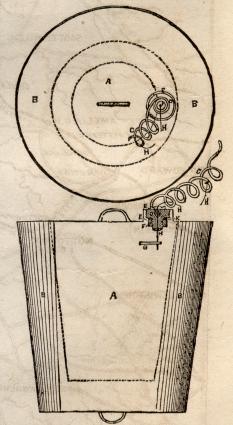 |
|||||||||||||||||||||
|
|
||
|
|
Site Copyright 2003-2018 Son of the South. For Questions or comments about this collection, contact paul@sonofthesouth.net |
|
|
Are you Scared and Confused? Read My Snake Story, a story of hope and encouragement, to help you face your fears. |
||
